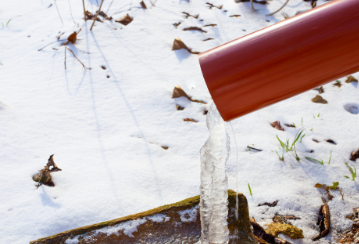Every spring, heavy rains and melting snow cause damage to Canadian’s basements as the water finds its way into their homes. However, as a homeowner there are steps you can take to keep the floods at bay and prevent water damage. Review these seven mistakes that often lead to costly water damage.
1. Accidentally blocking the weeping tile system
Weeping tiles are porous pipes with small holes that are placed in a trench outside the perimeter of the foundation to collect water and direct it away from the home. If you have a weeping tile system and are landscaping or re-grading your lawn, make sure that the landscaper is aware and doesn’t accidentally block the weeping tile spouts, reversing the flow of water back into your home.1
2. Using laminate flooring in a basement
Laminate flooring is extremely porous and easily damaged by water. If you get a leak, the laminate flooring soaks up the water and expands.1 Instead, use tile or vinyl flooring in your basement so that if you do get a leak, it won’t damage your floor.
3. Not having enough insulation in your roof or attic
When heat escapes upward to your attic or roof, it melts snow on the roof which then travels into your eaves troughs and refreezes. This can cause a build-up of ice that gets under your shingles into your attic and blocks your eavestroughs and downspouts. If you notice snow melting on your roof, consider adding more insulation to your attic.
4. Ignoring cracks in your foundation
Cracks in your basement walls or foundation should not be ignored. Check your foundation and basement walls each spring for signs of cracks. If you notice any, fix them right away before they get worse or water finds its way in. A small crack can be fixed with a concrete patch, but bigger concerns need a professional’s attention.2
5. Re-opening outdoor hose valves too early
During a Canadian spring, temperatures can fluctuate wildly. Don’t be tempted to open your outdoor hose valve at the first sign of warm weather — instead, wait until you’re confident that there isn’t a risk of temperatures dropping below freezing. If you open it too early, the water can freeze and burst your pipe, causing a flood in your home and expensive repairs.
6. Not cleaning gutters and downspouts
 When gutters and downspouts are clogged with leaves, debris or ice, they can’t do their job of controlling the flow of water. Make sure your gutters and downspouts are clear and ready for heavy rainfall before a storm hits and that they direct the water away from your home.
When gutters and downspouts are clogged with leaves, debris or ice, they can’t do their job of controlling the flow of water. Make sure your gutters and downspouts are clear and ready for heavy rainfall before a storm hits and that they direct the water away from your home.
7. Not getting overland water coverage
Water damage can get expensive very quickly. With extreme weather events on the rise, you can still be victim to flooding even if you take preventative measures. Overland water coverage can be added to your home insurance policy to cover flood damage caused by heavy rains or overflow of a body of fresh water. Talk to your insurance broker to find out if overland water coverage is available in your area and can be added it to your home insurance policy.
If you’re interested in finding out more about adding overland water coverage to your current OTIP home insurance policy, call 1-833-494-0089. If you’d like to get a quote for home insurance, call 1-833-615-9326.
1. CTV News
2. AJ Restores